Constitutional history of Germany
The Holy Roman Empire (962-1806)
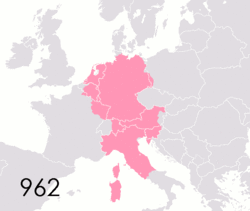
The Holy Roman Empire was a multi-ethnic complex of territories in Western and Central Europe that developed during the Early Middle Ages and continued until its dissolution in 1806 during the Napoleonic Wars.
The German Confederation (1815-1866)
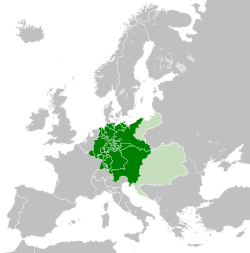
The German Confederation (German: Deutscher Bund) was an association of 39 German-speaking states in Central Europe, created by the Congress of Vienna in 1815 to coordinate the economies of separate German-speaking countries and to replace the former Holy Roman Empire.
The North German Confederation (1867-1870)

The German Confederation was dissolved after the Prussian victory in the Seven Weeks’ War over Austria in 1866. The dispute over which had the inherent right to rule German lands ended in favour of Prussia, leading to the creation of the North German Confederation under Prussian leadership in 1867, to which the eastern portions of the Kingdom of Prussia were added. A number of South German states remained independent until they joined the North German Confederation, which was renamed and proclaimed as the ”German Empire” in 1871 for the now unified Germany with the Prussian king as emperor (Kaiser) after the victory over French emperor Napoleon III in the Franco-Prussian War of 1870.
The German Empire (1871-1918)
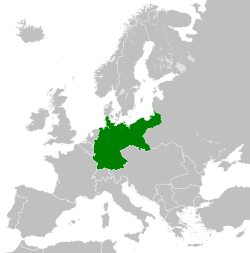
The German Empire (German: Deutsches Reich) consisted of 26 states, most of them ruled by royal families. They included four kingdoms, six grand duchies, five duchies (six before 1876), seven principalities, three free Hanseatic cities, and one imperial territory. Although Prussia was one of several kingdoms in the realm, it contained about two thirds of Germany’s population and territory. Prussian dominance was also established constitutionally. The monarchy collapsed in the November 1918 Revolution with the abdications of its monarchs.
The Weimar Republic (1919-1933)
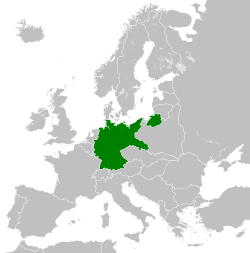
Germany became a republic in February 1919. The offical name of the state was still Deutsches Reich (German Empire) From 1920 the 26 states were reduced to 19, after 7 states formed the Free State of Thuringia. The territory of Saar was occupied and governed by the United Kingdom and France from 1920 to 1935 under a League of Nations mandate. The Free City of Danzig was also created in 1920 under a League of Nations mandate.
Nazi Germany (1933-1945)

In 1933 Germany was transformed into a totalitarian state that controlled nearly all aspects of life via the Gleichschaltung legal process. The constituing states were abolished in 1935. From 1938 onwards, Germany annexed neighbouring territories and countries, including Austria and Poland. The official name of the state was Deutsches Reich (German Empire) until 1943 and Großdeutsches Reich (Greater German Empire) from 1943 to 1945.
Germany under Allied occupation (1945-1949)

Upon defeat of Germany in World War II, the victorious Allies (USA, Great Britain, USSR and France) asserted joint authority and sovereignty over ’Germany as a whole’, defined as all territories of the former German Empire west of the Oder–Neisse line. Prussia, the main state of Germany, was officially abolished by an Allied declaration in 1947. During 1946-47 the Allies created new states on the territory of Germany. The states were largly based on previous German states or provinces of Prussia.
In practice, each of the four occupying powers wielded government authority in their respective zones and carried out different policies toward the population and local and state governments there. A uniform administration of the western zones evolved, known first as the Bizone (the American and British zones merged as of 1 January 1947) and later the Trizone (after inclusion of the French zone). The three western zones were merged to form the Federal Republic of Germany in May 1949, and the Soviets followed suit in October 1949 with the establishment of the German Democratic Republic (GDR). This meant that there were two separate states claiming to be ”Germany”. Neither recognised each other’s claim.
The German Democratic Republic (1949-1990)

The German Democratic Republic (German: Deutsche Demokratische Republic) was established as a communist country along Soviet lines. It had five states (plus East Berlin), which however where abolished in 1952.
After the November 1989 Revolution, the states were re-established in 1990.
The Federal Republic of Germany (1949-)
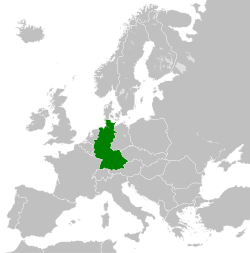
The Federal Republic of Germany (German: Bundesrepublik Deutschland) was established as a federal parliamentary republic with nine states in 1949. As in 1920, the Saar was once again separated from Germany in 1947. It was administred as a French protectorate until 1957 when it joined the Federal Republic of Germany.
The state of Berlin was jointly administred by the four Allied powers and could therefore neither join the Federal Republic of Germany nor the German Democratic Republic. As with Germany as a whole, Berlin was also divided in two parts.
In October 1990 the German Democratic Republic was dissolved and the five east German states (along with the reunited City of Berlin) joined the Federal Republic of Germany.
Germany was one of the founding members of the Treaties of Rome in 1958, which would later evolve to the European Union.
Parliamentary history of Germany
The Federal Convention (Bundesversammlung) (1815-1848, 1850-1866)
The Federal Convention (German: Bundesversammlung or Bundestag) was the only central institution of the German Confederation from 1815 until 1848, and from 1850 until 1866. The Federal Assembly had its seat in the Palais Thurn und Taxis in Frankfurt. It was organized as a permanent congress of envoys. The Federal Assembly was presided over by the Austrian delegate and consisted of two executive bodies: the inner council and the plenary session. Its members were not elected, neither by popular vote nor by state parliaments (which even didn’t exist in some member states), but had been appointed by the state governments or by the state’s prince.
North German Reichstag (1867-1870)
The North German Constitution of 16 April 1867 created a national parliament with universal suffrage (for men above the age of 25), the Reichstag. Members were elected in single-member constituencies by majority vote. If no candidate received a majority of the votes, a runoff election took place. Another important institution was the Bundesrat, the ’federal council’ of the representatives of the allied governments. To adopt a law, a majority in the Reichstag and in the Bundesrat was necessary. This gave the allied governments, meaning the states and their princes, an important veto.
Customs Parliament (1868-1870)
In June 1867 a conference took place between Prussia and the south German states, who were not members of the North German Confederation. After pressure from Prussia, new Customs Union (Zollverein) treaties were signed the following month. Henceforth, the governing bodies of the Customs Union were the Bundesrat and Reichstag of the North German Confederation, augmented by representatives of the south German governments in the former and members from these states elected in the same way as the others in the latter. When augmented thus for customs matters, the institutions were known as the Federal Customs Council and the Customs Parliament (Zollparlament).
The Reichtag of the German Empire (1871-1918)
The Reichstag had no formal right to appoint or dismiss governments, but by contemporary standards it was considered a highly modern and progressive parliament. All German men over 25 years of age were eligible to vote, and members of the Reichstag were elected by general, universal and secret suffrage. Members were elected in single-member constituencies by majority vote. If no candidate received a majority of the votes, a runoff election took place. In 1871, the Reichstag consisted of 382 members, but from 1874 when the occupied French Alsace-Lorraine territory was integrated with the German Empire it was enlarged to 397 members.
The Reichstag of the Weimar Republic (1919-1933)
The members of the Reichstag were elected by general universal suffrage according to the principle of proportional representation. Votes were cast for nationwide party lists. The term of the legislature was four years. The number of members of the Reichstag wasn’t fixed, but depended on the total number of votes cast in each election. Around 60 000 votes equalled one seat.
The Reichstag of Nazi Germany (1933-1945)
The Enabling Act of 1933 was an amendment to the Weimar Constitution that gave the German Cabinet — in effect, Chancellor Adolf Hitler — the power to enact laws without the involvement of the Reichstag. The act passed in both the Reichstag and Reichsrat on 23 March 1933, and was signed by President Paul von Hindenburg later that day. The act stated that it was to last four years unless renewed by the Reichstag, which occurred twice. After the passing of the Enabling Act of 1933, the Reichstag met only as a rubber stamp for the actions of Adolf Hitler’s dictatorship — always by unanimous consent — and to listen to Hitler’s speeches. In this purely ceremonial role, the Reichstag convened only 20 times, the last on 26 April 1942. While elections were still held, voters were presented with a single list comprising Nazis and ”guests” of the party. These ”guests,” however, fully supported Hitler. Elections during this time were not secret; voters were often threatened with severe reprisals if they failed to vote or dared to vote no. Under the circumstances, the Nazi list carried with well over 90 percent of the vote each time.
The People’s Chamber (Volkskammer) of the German Democratic Republic (1949-1990)
The People’s Chamber (Volkskammer) was the unicameral legislature of the German Democratic Republic. The People’s Chamber was initially the lower house of a bicameral legislature. The upper house was the Chamber of States, or Länderkammer, but in 1952 the states of East Germany were dissolved, and the Chamber was abolished in 1958.
The members of the chamber were elected in multi-member constituencies, with four to eight seats. Suffrage was universal, and legislative periods were four years, five years after 1981. Only one list of candidates appeared on the ballot paper, a list from the National Front, a popular front/electoral alliance dominated by the Socialist Unity Party of Germany (SED). Seats between the parties of the National Front were apportioned based on a set quota, not actual vote totals.
Initially, voters in East Berlin could not take part in elections to the Volkskammer, in which they were represented by indirectly-elected non-voting members, but in 1979 the electoral law was changed to provide for 66 directly elected deputies with full voting rights.
In practice, the People’s Chamber was a rubber stamp that did little more than give legal sanction to decisions already made by the Socialist Unity Party of Germany (SED) and its Politburo.
In 1990, free and fair multi party elections to the Volkskammer were held.
The Bundestag of the Federal Republic of Germany (1949-)
The Bundestag was established by the Constitution of the Federal Republic of Germany in 1949 as one of the legislative bodies of Germany and thus the historical successor to the earlier Reichstag. Because Berlin was not officially under the jurisdiction of the Constitution until 1990 the Bundestag met in Bonn until 1999, when it moved to Berlin. From 1949 to 1990, the legislative of (West) Berlin only sent observers to the Bundestag.
Members serve four-year terms, with elections held every four years, or earlier in the relatively rare case that the Bundestag is dissolved prematurely by the president. Half of the members are elected proportionally through party lists, wheras the other half are elected in single-member constituencies by majority vote. Thus, each voter have two votes to cast: on a party list and on a candidate in a single-member constituency. However, the total share of seats of each party is decided by the share of votes on party lists. In addition, the Bundestag has a minimum threshold of either 5% of the national party vote or three (directly elected) constituency representatives for a party to gain additional representation through the system of proportional representation.
The Bundestag after the German unification in 1990
When Berlin and the five states of the former German Democratic Republic joined the Federal Republic of Germany on 3rd of October 1990, 144 representatives from the Volkskammer of the German Democratic Republic gained full membership in the Bundestag, as did the 22 observers from (West) Berlin, thus rising the number of members at the 11th legislative period (1987-1990) from 497 to 663.
Elections to the 12th legislative period of the Bundestag took place on 2nd of December 1990. For this election only, the Constitutional court of the Federal Republic of Germany had judged that the 5% threshold should not be applied nationwide, but separately for East Germany (including East Berlin) and West Germany (including West Berlin).